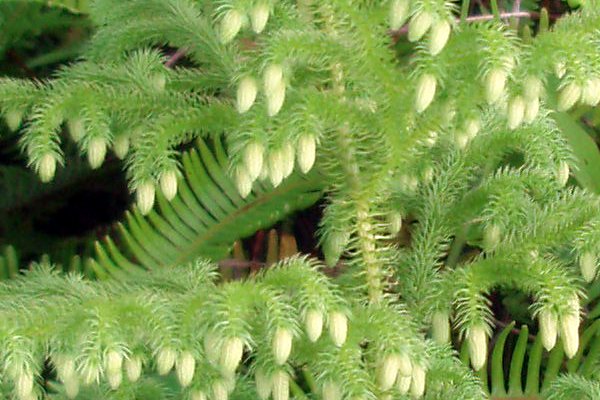1.
 Name the morphological features of this Lycopodiella cernua seen on the seedless vascular plant hike on 21 August 2007.
Name the morphological features of this Lycopodiella cernua seen on the seedless vascular plant hike on 21 August 2007.
[labels with lines should be on drawing] Lycopodiella cernua
has awl-shaped microphylls instead of true leaves. At the terminal end of each branch a single strobilus (cone) forms. In the image the strobili (cones) are the white conical shapes. Lycopodium are seedless vascular plants. This means Lycopodium do not produce seeds. The strobili produce spores. Each spore is a single cell. The spores are very small and appear only as dust to human eyes. Lycopodium has no flower and no fruit. The word "morphilogical" means "the shape of the..."
2.
When working in the ethnobotanical garden across the entrance road I noted that ferns should not be cut. The rule is that ferns are to be kept, retained. Why would we want to retain ferns in ethnobotanical garden? Your answer should be written from an ethnobotanical perspective.
Ferns are native plants. Native means that they are considered plants that belong naturally on Pohnpei and are a part of the natural landscape. Native plants belong here on Pohnpei. Native plants are contrasted with introduced plants. Some introduced plants are economically useful or beneficial. Some introduced plants are, however, invasive. In the ethnobotanical garden the "battle" is against the introduced invasive razor grass known locally as reh padil. Other introduced invasives include the small yellow daisy, the sensitive mimosa, and Chromolaena odorata. As one student wrote, "When one cuts down a fern, he is creating a chance for another unwanted species of plants to overgrow the place."
In addition, ferns are locally useful plants. Ferns are used medicinally, for decoration, and even in the construction of local huts and homes. Some are even used in soups.
3.
Based on the reproductive cycle of ferns from the 24 January seedless vascular plant presentations, label the reproductive features of this Antrophyum spp fern and describe their role in fern reproduction.
[sori should be labelled] The small, dark, circular "dots" are called sori. Each dark circle is considered a single sorus. The sori produce spores. The spores are released into and carried by the wind. If a spore settles on fertile ground, then the spore produces a gametophyte - a small almost moss-like miniature plant that produces sperm and eggs.
Ferns are not that useful for producing shade. The trees help produce shade that slows the growth of the razor grass.
4.
Distinguish between "public" and "private" healing plant knowledge.
Public plant knowledge is broadly known knowledge. Knowledge that is commonly held. Many people know this information, and the information is not considered a secret. Noni is widely used by those with diabetes, Ocimum tenuiflorum in hot water helps relieve nasal congestion, and Senna alata is used to treat fungal diseases of the skin. Ethnobotanists tend to consider public plant knowledge as being more likely to be effective. The multi-island usage indicates that this is a cure that really works.
Private plant knowledge are secret recipes. In Micronesia these secret formulas are usually held within a family and held by a single person in that family. This knowledge is usually passed down to a single son or daughter.
Privately held plant knowledge is not necessarily harmful nor hurtful medicine. Of note, however, is that all harmful plant knowledge is privately held and not publicly shared.
5.
On 23 September the class visited the Pohnpei Botanic garden at Pwunso.
On the top center of the palm-like cycad was an odd structure seen in the image below.
Based on the presentations of 30 September, what is the structure and what is the role of the structure in reproduction for the cycad?
The structure is a cone. Male cycad cones produce pollen which is a multi-cellular structure that contains the sperm cell. Pollen is carried by the wind to female cycad cones. After fertilization, the cycads produce seeds inside the female cone. The production of pollen and seeds are key differences between cycads and the seedless vascular spore-producing plants studied earlier in the term.
6.
List the economically important plants and their uses that the class encountered on the 23 September field trip to the
Pohnpei Botanic garden at Pwunso. [answers will vary]
7.
In the healing plant presentations of 16 and 18 September three different methods of administering healing plants
were described for the treatment of fevers and coughing often associated with flu.
Describe the three different methods mentioned in class on those days.
[Answers will vary. The following are three distinct methods]
- Steam bath: place the medicinal plant part in boiling water and inhale the vapors.
- Tea: place the medicinal plant part in boiling water. Allow to cool. Drink.
- Absorption through skin: heat leaves (usually on uhm rocks) and then apply hot leaves to skin. Alternatively, lay a feverish person (no clothes) on a mat of the leaves and allow leaves to contact their skin.
 Name the morphological features of this Lycopodiella cernua seen on the seedless vascular plant hike on 21 August 2007.
Name the morphological features of this Lycopodiella cernua seen on the seedless vascular plant hike on 21 August 2007.